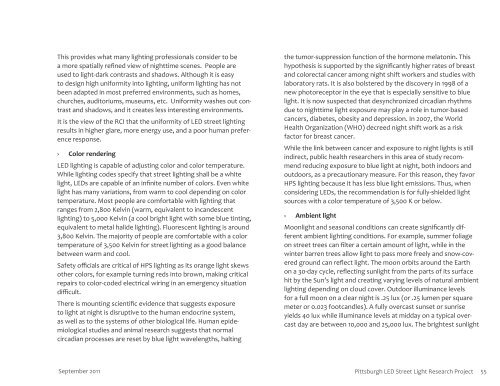LED Street Light Research Project
LED Street Light Research Project
LED Street Light Research Project
Create successful ePaper yourself
Turn your PDF publications into a flip-book with our unique Google optimized e-Paper software.
This provides what many lighting professionals consider to be<br />
a more spatially refined view of nighttime scenes. People are<br />
used to light-dark contrasts and shadows. Although it is easy<br />
to design high uniformity into lighting, uniform lighting has not<br />
been adapted in most preferred environments, such as homes,<br />
churches, auditoriums, museums, etc. Uniformity washes out contrast<br />
and shadows, and it creates less interesting environments.<br />
It is the view of the RCI that the uniformity of <strong>LED</strong> street lighting<br />
results in higher glare, more energy use, and a poor human preference<br />
response.<br />
› Color rendering<br />
<strong>LED</strong> lighting is capable of adjusting color and color temperature.<br />
While lighting codes specify that street lighting shall be a white<br />
light, <strong>LED</strong>s are capable of an infinite number of colors. Even white<br />
light has many variations, from warm to cool depending on color<br />
temperature. Most people are comfortable with lighting that<br />
ranges from 2,800 Kelvin (warm, equivalent to incandescent<br />
lighting) to 5,000 Kelvin (a cool bright light with some blue tinting,<br />
equivalent to metal halide lighting). Fluorescent lighting is around<br />
3,800 Kelvin. The majority of people are comfortable with a color<br />
temperature of 3,500 Kelvin for street lighting as a good balance<br />
between warm and cool.<br />
Safety officials are critical of HPS lighting as its orange light skews<br />
other colors, for example turning reds into brown, making critical<br />
repairs to color-coded electrical wiring in an emergency situation<br />
difficult.<br />
There is mounting scientific evidence that suggests exposure<br />
to light at night is disruptive to the human endocrine system,<br />
as well as to the systems of other biological life. Human epidemiological<br />
studies and animal research suggests that normal<br />
circadian processes are reset by blue light wavelengths, halting<br />
September 2011<br />
the tumor-suppression function of the hormone melatonin. This<br />
hypothesis is supported by the significantly higher rates of breast<br />
and colorectal cancer among night shift workers and studies with<br />
laboratory rats. It is also bolstered by the discovery in 1998 of a<br />
new photoreceptor in the eye that is especially sensitive to blue<br />
light. It is now suspected that desynchronized circadian rhythms<br />
due to nighttime light exposure may play a role in tumor-based<br />
cancers, diabetes, obesity and depression. In 2007, the World<br />
Health Organization (WHO) decreed night shift work as a risk<br />
factor for breast cancer.<br />
While the link between cancer and exposure to night lights is still<br />
indirect, public health researchers in this area of study recommend<br />
reducing exposure to blue light at night, both indoors and<br />
outdoors, as a precautionary measure. For this reason, they favor<br />
HPS lighting because it has less blue light emissions. Thus, when<br />
considering <strong>LED</strong>s, the recommendation is for fully-shielded light<br />
sources with a color temperature of 3,500 K or below.<br />
› Ambient light<br />
Moonlight and seasonal conditions can create significantly different<br />
ambient lighting conditions. For example, summer foliage<br />
on street trees can filter a certain amount of light, while in the<br />
winter barren trees allow light to pass more freely and snow-covered<br />
ground can reflect light. The moon orbits around the Earth<br />
on a 30-day cycle, reflecting sunlight from the parts of its surface<br />
hit by the Sun’s light and creating varying levels of natural ambient<br />
lighting depending on cloud cover. Outdoor illuminance levels<br />
for a full moon on a clear night is .25 lux (or .25 lumen per square<br />
meter or 0.023 footcandles). A fully overcast sunset or sunrise<br />
yields 40 lux while illuminance levels at midday on a typical overcast<br />
day are between 10,000 and 25,000 lux. The brightest sunlight<br />
Pittsburgh <strong>LED</strong> <strong>Street</strong> <strong>Light</strong> <strong>Research</strong> <strong>Project</strong> 55


